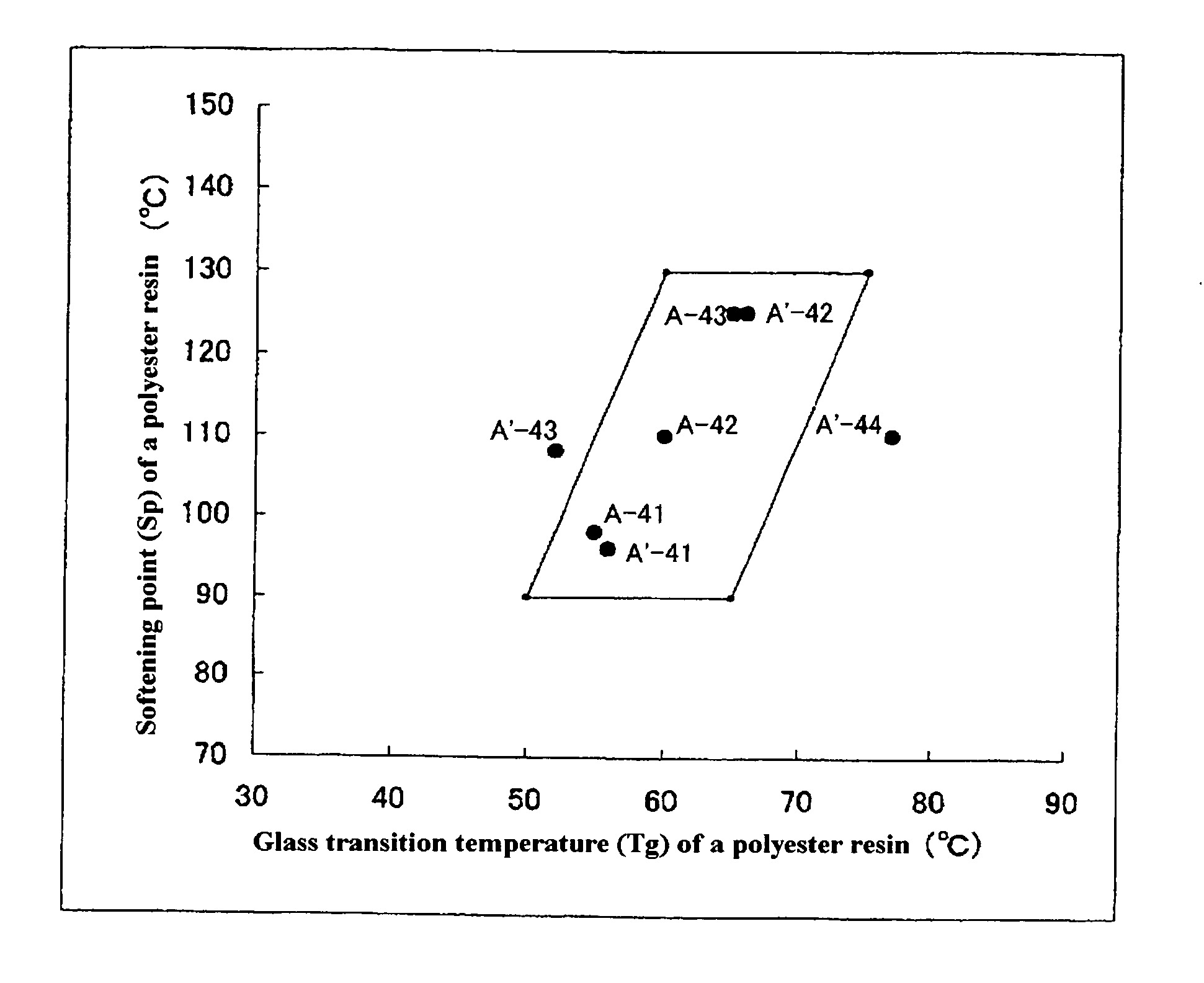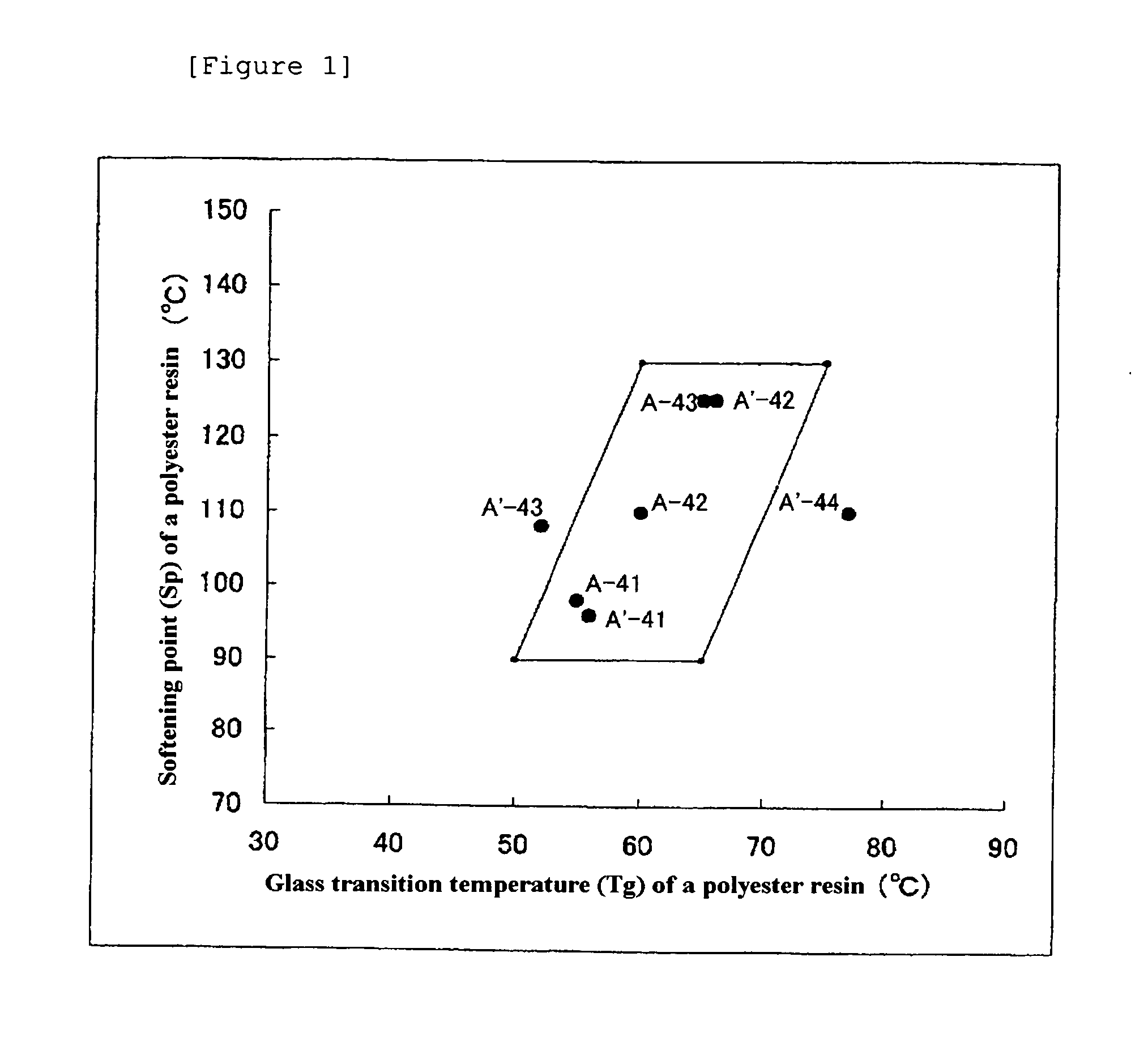Polyester Resin for Toner, Toner Composition and Resin Particle
- Summary
- Abstract
- Description
- Claims
- Application Information
AI Technical Summary
Benefits of technology
Problems solved by technology
Method used
Image
Examples
examples
[0461] Hereinafter the invention will be described more in detail, however it is not intended that the invention be limited to the described Examples.
[0462] The methods of measuring the properties of the polyester resins obtained by Examples within the scope of the respective inventions and Comparative Examples will be described below.
1. Hydroxy Value
[0463] A method standardized in JIS K 1557 (1970).
[0464] In the case there were solvent-insoluble fractions in samples due to crosslinking, the samples were melted and kneaded by the following method and used for measurement.
[0465] Kneader: LaboPlast Mill MODEL 30R150, manufactured by Toyo Seiki Seisaku-Sho Ltd.
[0466] Kneading conditions: at 130° C. and 70 rpm for 30 minutes
2. Acid Value
[0467] A method standardized in JIS K 0070 (1992).
[0468] In the case there were solvent-insoluble fractions in samples due to crosslinking, the samples were melted and kneaded by the same method as that in the case of the hydroxy value and use...
examples 1 to 4
, Comparative Examples 1 to 4
Example 1
Synthesis of Linear Polyester
[0470] To a reaction tank equipped with a cooling tube, a stirrer, and a nitrogen introduction tube, 1,2-propylene glycol (hereinafter, simply referred to as propylene glycol) 639 part (24.5 mole), bisphenol A-2 mole EO adduct 180 part (1.6 mole), terephthalic acid dimethyl ester 653 part (9.8 mole), adipic acid 10 part (0.2 mole), and as a condensation catalyst, tetrabutoxy titanate 3 part were loaded and under nitrogen gas stream, reaction was carried out at 180° C. for 8 hours while the produced methanol was removed. Successively, while the reaction system was gradually heated to 230° C. and the produced propylene glycol and water were removed under nitrogen gas stream, reaction was carried out for 4 hours and further continued at a pressure reduced to 5 to 20 mmHg and the product was discharged when the softening point reached 90° C. The recovered propylene glycol was 263 part (10.1 mole). After cooled to a roo...
example 2
Synthesis of Linear Polyester
[0477] To the reaction tank same as that of Example 1, propylene glycol 720 part (23.8 mole), terephthalic acid dimethyl ester 735 part (9.8 mole), adipic acid 29 part (0.5 mole), and tetrabutoxy titanate 3 part were loaded and reaction was carried out in the same manner as that for the linear polyester (Aa-1) of Example 1 and the product was discharged when the softening point reached 94° C. The recovered propyleneglycol was 235 part (7.8 mole). After cooled to a room temperature, the discharged resin was pulverized for granulation. The obtained product was linear polyester (Aa-2).
[0478] The linear polyester (Aa-2) had 2700 of Mn, 5800 of Mp, 2.0% of the content of components with 500 or lower molecular weight, 0% of the THF-insoluble fractions, 73 kJ of En, 300 of G′, Tm of 90° C., 5 to 11 of tan δ.
[Synthesis of Non-Linear Polyester]
[0479] To the reaction tank same as described above, propylene glycol 663 part (22.5 mole), terephthalic acid dimethy...
PUM
| Property | Measurement | Unit |
|---|---|---|
| Temperature | aaaaa | aaaaa |
| Temperature | aaaaa | aaaaa |
| Temperature | aaaaa | aaaaa |
Abstract
Description
Claims
Application Information
 Login to View More
Login to View More - R&D
- Intellectual Property
- Life Sciences
- Materials
- Tech Scout
- Unparalleled Data Quality
- Higher Quality Content
- 60% Fewer Hallucinations
Browse by: Latest US Patents, China's latest patents, Technical Efficacy Thesaurus, Application Domain, Technology Topic, Popular Technical Reports.
© 2025 PatSnap. All rights reserved.Legal|Privacy policy|Modern Slavery Act Transparency Statement|Sitemap|About US| Contact US: help@patsnap.com



